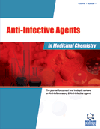- Home
- A-Z Publications
- Anti-Infective Agents in Medicinal Chemistry (Formerly Current Medicinal Chemistry - Anti-Infective Agents)
- Previous Issues
- Volume 9, Issue 4, 2010
Anti-Infective Agents in Medicinal Chemistry (Formerly Current Medicinal Chemistry - Anti-Infective Agents) - Volume 9, Issue 4, 2010
Volume 9, Issue 4, 2010
-
-
Structure-based Discovery of Novel Antibacterials
More LessAuthors: Huan-Qiu Li, Peng-Cheng Lv, Lei Shi and Hai-Liang ZhuAn increasing fraction of bacterial isolates show reduced susceptibility to our most trusted antibiotics. In order to prevent this serious medical problem, the elaboration of new types of antibacterial agents or the expansion of bioactivity of the previous drugs is a very important task. Different targets in key areas of the bacterial cell cycle have been studied that would be a new weapon against this threat. In this review Read More
-
-
-
Novel, Unifying Phagomimetic Mechanism of Vancomycin Therapeutic Action and Toxicity: Polyphenol, Electron Transfer and Reactive Oxygen Species
More LessAuthors: Peter Kovacic and Ratnasamy SomanathanIn recent years, vancomycin has received appreciable attention as an antibiotic drug of last resort. The generally accepted mechanism entails interference with bacterial cell wall synthesis. There is negligible attention to other modes, even though drug action is often multifaceted. This review provides a hypothesis for an additional mechanism of antibacterial action based on the polyphenol residue in the glycopeptide. T Read More
-
-
-
Emerging Antimicrobial Applications of Nitric Oxide (NO) and NO-Releasing Materials
More LessAuthors: Genevieve M. Halpenny and Pradip K. MascharakDuring the past few decades, the potential of treating infections with nitric oxide (NO) has been firmly demonstrated in various laboratories. Both in vitro and in vivo studies have afforded promising results in terms of reducing microbial loads in chronic wounds in addition to its utility in keeping medical devices free of thrombus formation and bacterial adhesion. The latter antimicrobial effects of NO provide great help in successf Read More
-
-
-
Investigation of 2-Fluoro Benzoic Acid Derivatives as Influenza A Viral Sialidase Selective Inhibitors
More LessNeuraminidase (NA), a glycoside hydrolase enzyme, plays pivotal roles in controlling biological functions not only of influenza viruses but also of humans. Zanamivir and oseltamivir designed to target influenza neuraminidase have become extensively used for influenza clinical treatment as its high anti-influenza efficacy. Unfortunately, side effects of these two drugs have been reported in clinical use. An aromatic benzene ring Read More
-
-
-
Synthesis of Some New Monocyclic β-Lactams Bearing a Morpholine Moiety at their N1 Positions as Antifungal Agents
More LessThe synthesis of 40 new monocyclic β-lactams bearing a morpholine moiety at their N1 positions is described. The structures of these compounds have been confirmed by IR, 1H-NMR, 13C-NMR, Mass spectra and Elemental analysis. The antimicrobial activities of the synthetic compounds have been tested against clinically important fungi including Candida, Aspergillus and Microsporum and Epidermophyton species by broth mic Read More
-
Most Read This Month
Article
content/journals/aiamc
Journal
10
5
false
en


